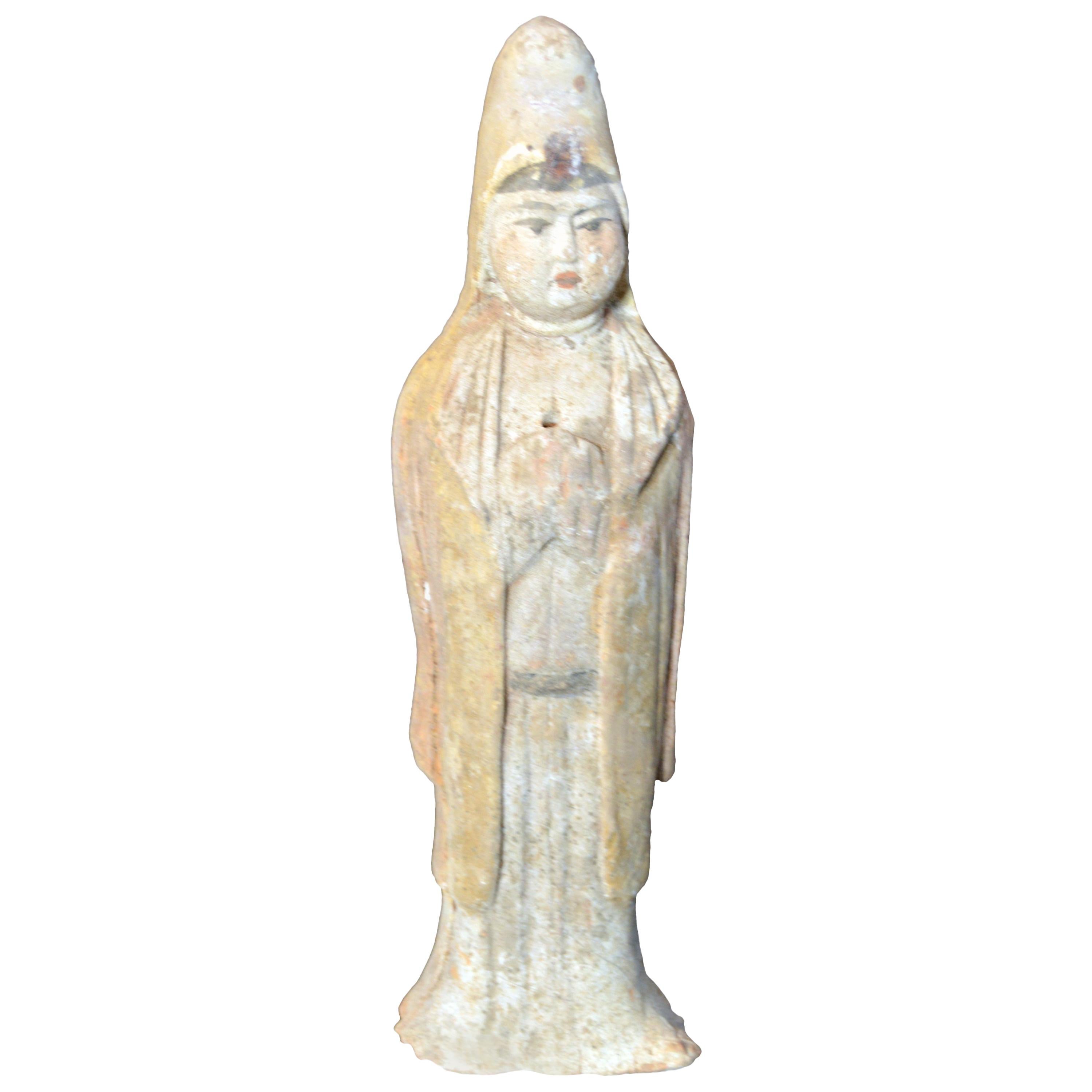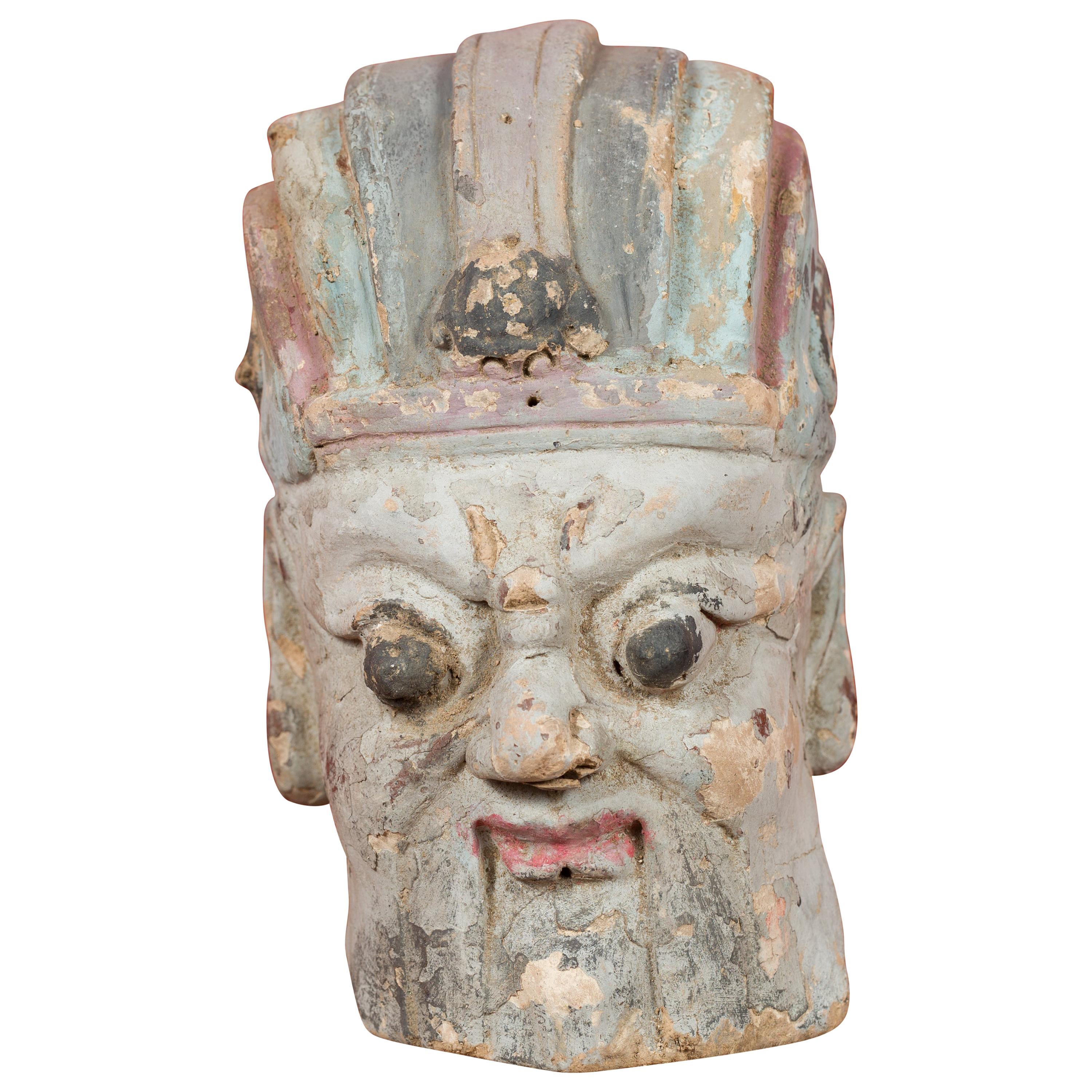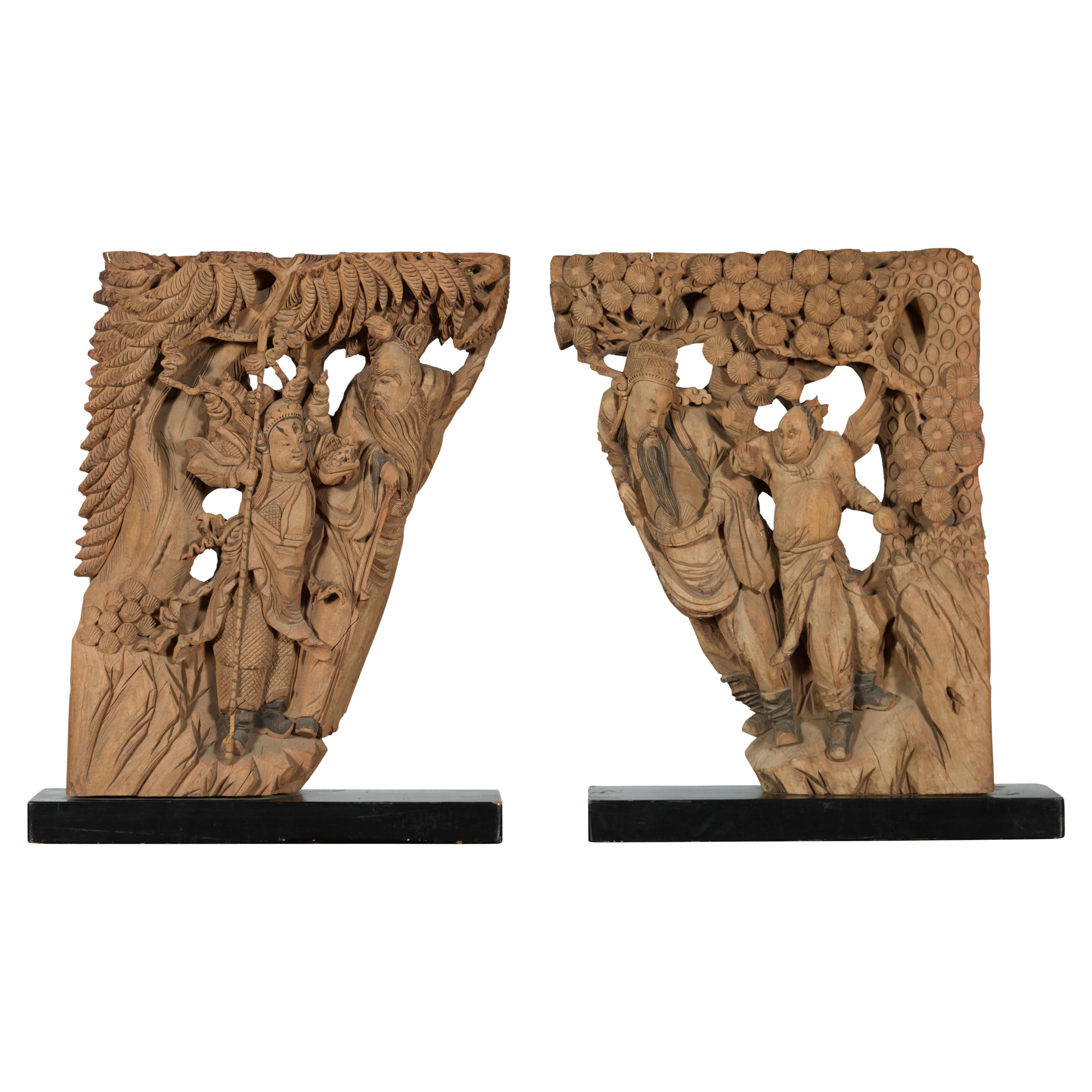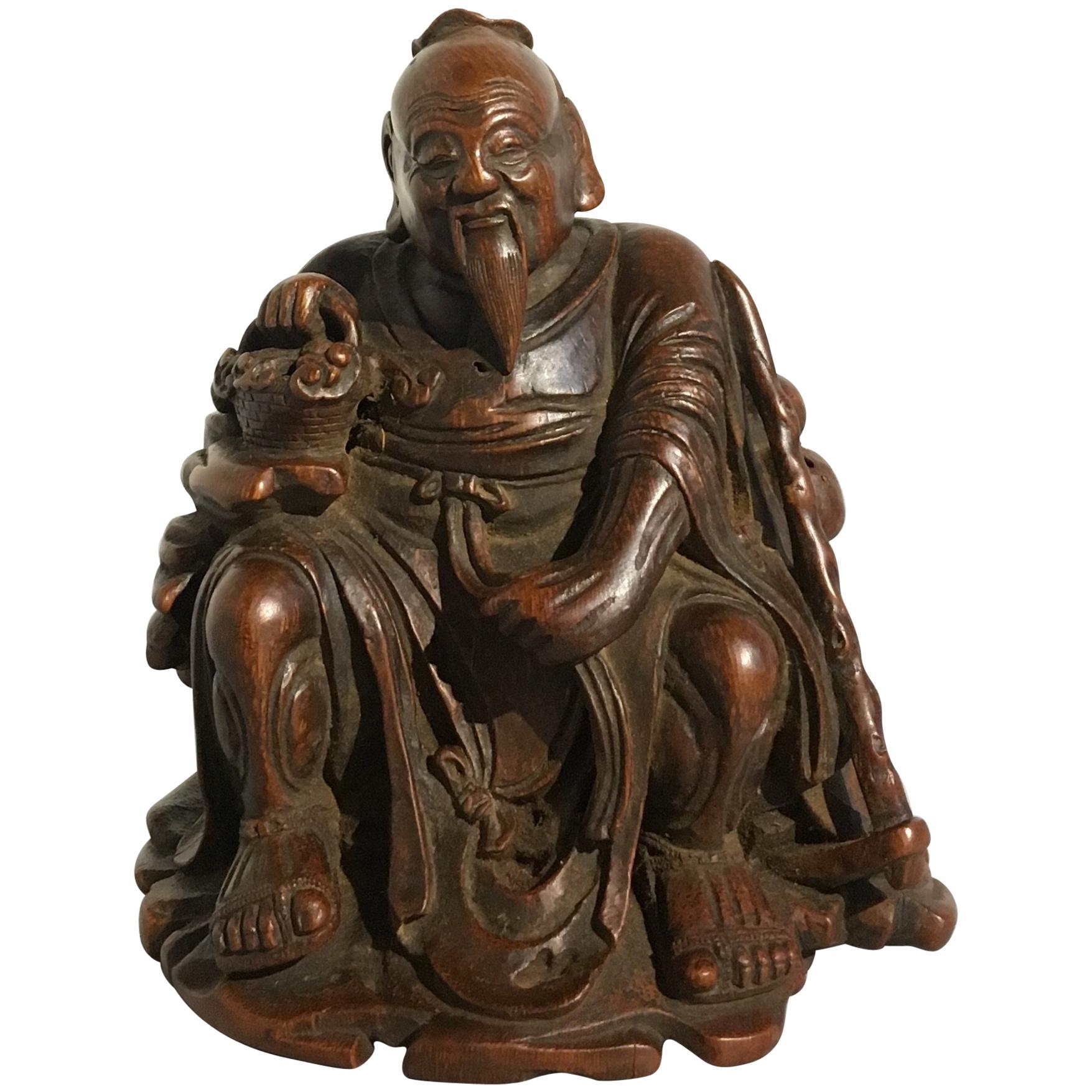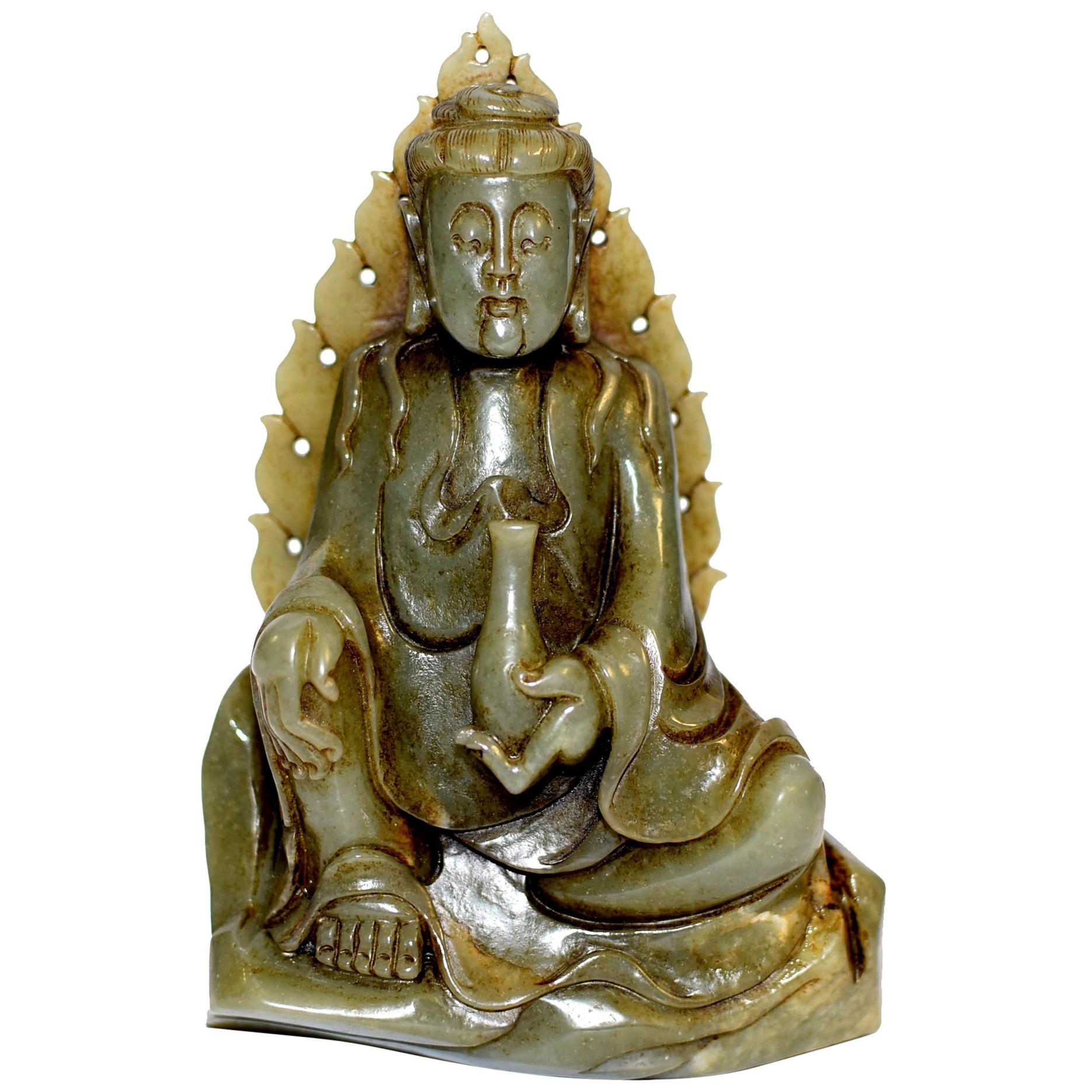Items Similar to Pair of Qing Dynasty Early 20th Century Small Hand Painted Terracotta Statues
Want more images or videos?
Request additional images or videos from the seller
Pair of Qing Dynasty Early 20th Century Small Hand Painted Terracotta Statues
About the Item
A pair of Qing dynasty 20th century terracotta Chinese hooded priestess sculptures with original paint. Discover the exquisite charm of this pair of 20th century Qing dynasty terracotta Chinese hooded priestess sculptures. These small, hollow statues, meticulously crafted during the Qing dynasty (1644-1912), depict standing priestesses adorned in dresses with hoods and hands joined on their chests. Their round faces and attire reflect the influence of the Mongolian steppes, evoking the elegance of earlier Tang dynasty pieces. With petite proportions and traces of original paint, these statues exhibit a nicely weathered patina, adding a touch of historical authenticity.
Ideal for enhancing your home décor, these Qing terracotta priestess statues can be beautifully displayed on a shelf, atop a commode, or a side table. Their delicate presence makes them perfect for creating a charming vignette, particularly when paired with complementary items like LU863918103252 (sold separately). These statues are not only a testament to ancient Chinese artistry but also a versatile decorative addition that brings a touch of timeless elegance to any interior setting. Add a piece of history to your collection with these captivating Qing dynasty priestess sculptures.
- Dimensions:Height: 10 in (25.4 cm)Width: 3 in (7.62 cm)Depth: 2 in (5.08 cm)
- Sold As:Set of 2
- Style:Qing (Of the Period)
- Materials and Techniques:
- Place of Origin:
- Period:
- Date of Manufacture:Early 20th Century
- Condition:Wear consistent with age and use. Please refer to the various additional photos for further condition detail and contact us with any questions!
- Seller Location:Yonkers, NY
- Reference Number:
About the Seller
5.0
Platinum Seller
These expertly vetted sellers are 1stDibs' most experienced sellers and are rated highest by our customers.
Established in 1968
1stDibs seller since 2009
923 sales on 1stDibs
Typical response time: <1 hour
- ShippingRetrieving quote...Ships From: Yonkers, NY
- Return PolicyA return for this item may be initiated within 3 days of delivery.
More From This SellerView All
- Chinese Qing Dynasty 19th Century Small Hand-Painted Terracotta Priestess StatueLocated in Yonkers, NYA 19th century Chinese standing priestess sculpture made from terracotta during the later stages of the Qing dynasty with traces of original paint. This small hollow statue displays ...Category
Antique 19th Century Chinese Qing Sculptures and Carvings
MaterialsTerracotta
- Antique Chinese Qing Dynasty Hand Painted Terracotta Head with HeaddressLocated in Yonkers, NYAn antique Chinese Qing hand painted terracotta head from the 19th century, with striking features and headdress. Created in China during the Qing Dynasty, this painted terracotta head captures our attention with its soft colors and nicely distressed appearance complimenting its striking features perfectly. Topped with a tall headdress, this Chinese head sculpture...Category
Antique 19th Century Chinese Qing Sculptures and Carvings
MaterialsTerracotta
- Pair of 19th Century Chinese Qing Dynasty Hand-Carved Wooden Temple CorbelsLocated in Yonkers, NYA pair of Chinese Qing Dynasty period hand-carved temple corbels from the 19th century, mounted on black bases. Created in China during the Qing Dynasty...Category
Antique 19th Century Chinese Qing Figurative Sculptures
MaterialsWood
- Pair of Qing Dynasty Hand-Carved Wooden Temple Corbels with Deer MotifsLocated in Yonkers, NYA pair of Chinese Qing Dynasty hand-carved wooden temple corbels from the 18th or 19th century with deer and their young. Originally part of a temple wa...Category
Antique 18th Century Chinese Qing Animal Sculptures
MaterialsWood
- Indian Early 20th Century Hand Painted Wooden Cow with Distressed PatinaLocated in Yonkers, NYAn Indian hand painted and carved wooden cow from the early 20th century, with nicely weathered patina. Created in India during the early years of the 20th century, this wooden cow sculpture charms us with its archaic features and aged appearance. Resting on its four legs and showcasing large cracks, this Indian cow...Category
Early 20th Century Indian Rustic Animal Sculptures
MaterialsWood
- Petite Chinese Early Qing Dynasty Red Sand Figurine from the 17th CenturyLocated in Yonkers, NYAn antique Chinese early Qing dynasty red sand figurine from the 17th century. Arms crossed on the chest, holding an object perhaps a scroll, this Qing Chinese figurine attracts our attention with its nice age, petite proportions and red undertone. The large capped face, adorned with jewelry and exuding a serene expression, stands out beautifully on a rather flat body, simply outlined with two thin arms and legs. Placed anywhere in a home, this Chinese 17th century sandstone figurine...Category
Antique 17th Century Chinese Sculptures and Carvings
MaterialsSandstone
You May Also Like
- Chinese Carved Bamboo Figure of a Sage, Qing Dynasty, 18th CenturyLocated in Austin, TXA sweet and lovely Chinese bamboo carving of the sage Dongfang Shuo, mid-Qing dynasty, 18th century, China. Well carved form a single section o...Category
Antique 19th Century Chinese Qing Sculptures and Carvings
MaterialsBamboo
- Antique Nephrite Jade Buddha Statue Qing DynastyLocated in Somis, CAA Qing dynasty, hand carved, lustrous, solid natural nephrite green jade Buddha. Carved seated on a rock against flame-shaped mandorla, the broad-faced figure rendered with a serene expression by downcast eyes beneath high arched brows above pursed lips, flanked by long pendulous ear lobes and beneath a pronounced hairline framing the forehead and hair gathered into a bun. Buddha holds a vase in the left hand while his right hand rests on the right knee. A long robe drapes gracefully pooling around the legs exposing the right foot. The prominent "y" shape formed by the strong nose and high brows is typical of 18th century Qian Long...Category
Antique 19th Century Chinese Sculptures and Carvings
MaterialsJade
- Tang Dynasty Painted Terracotta Sculpture of a LokapalaBy Tang DynastyLocated in Dallas, TXTang Dynasty terracotta Pottery Tomb figure of the Lokapala Warrier Deity. Figure molded wearing heavy armor, standing in a dynamic pose with left arm raised in a threatening gesture...Category
Antique 15th Century and Earlier Chinese Tang Figurative Sculptures
MaterialsTerracotta
- Larger Than Life Terracotta Buddha Bust of Guanyin, Early 20th Century, ChinaLocated in Antwerp, BEA massive larger than life terracotta buddha bust of Guan Yin, China, early 20th century. Broken and restored with wear and tear from enduring exposure to the elements. Size: 75 cm high. Weight: 40 kg. Guanyin, Kwanyin, Guanshiyin or Guanyin Pusa is the Chinese interpretation of the bodhisattva Avalokiteśvara (the goddess of comfort and mercy). In addition, she is seen in Taoism as an immortal. The scripture dedicated to her is Dabeizhou. Guanyin is the goddess of compassion and the sea. She is one of the three saints of the western paradise, along with Mahasthamaprapta and Amitabha Buddha; they are worshiped to save departed loved ones from hell and grant them entrance to the western paradise. Guanyin Chinese name Traditional Chinese 觀音 Simplified Chinese 观音 Transcriptions Full Chinese name Traditional Chinese 觀世音 Simplified Chinese 观世音 Literal meaning "[The One Who] Perceives the Sounds of the World" Transcriptions Second alternative Chinese name Traditional Chinese 觀自在 Simplified Chinese 观自在 Literal meaning "Lord who Gazes down on the World" Transcriptions Burmese name Burmese ကွမ်ယင် IPA [kwàɴ jɪ̀ɴ] Tibetan name Tibetan སྤྱན་རས་གཟིགས Vietnamese name Vietnamese alphabet Quan Âm (Quán Âm) Quán Thế Âm (Quan Thế Âm) Quán Tự Tại Chữ Hán 觀音 觀世音 觀自在 Thai name Thai กวนอิม, พระอวโลกิเตศวรโพธิสัตว์ RTGS Kuan Im, Phra Avalokitesuan Korean name Hangul 관음, 관세음, 관자재 Hanja 觀音, 觀世音, 觀自在 Transcriptions Mongolian name Mongolian script ᠨᠢᠳᠦ ᠪᠡᠷ ᠦᠵᠡᠭᠴᠢ Japanese name Kanji 観音, 観世音, 観自在 Hiragana かんのん, かんぜおん, かんじざい Transcriptions Indonesian name Indonesian Kwan Im, Kwan She Im, Awalokiteswara Filipino name Tagalog Guanyin (ᜄᜓᜀᜈᜌᜒᜈ) Sanskrit name Sanskrit अवलोकितेश्वर (Avalokiteśvara) Khmer name Khmer អវលោកិតេស្វរៈ (Avalokitesvarak), អវលោកេស្វរៈ (Avalokesvarak), លោកេស្វរៈ (Lokesvarak) Hmong name Hmong Kabyeeb, Niam-Txiv Kabyeeb, Dabpog, Niam-Txiv Dabpog Guanyin (traditional Chinese: 觀音; simplified Chinese: 观音; pinyin: Guānyīn) is a Bodhisattva associated with compassion. She is the East Asian representation of Avalokiteśvara (Sanskrit: अवलोकितेश्वर) and has been adopted by other Eastern religions, including Chinese folk religion.[note 1] She was first given the appellation "Goddess of Mercy" or "Mercy Goddess" by Jesuit missionaries in China.[1] Guanyin is short for Guanshiyin, which means "[The One Who] Perceives the Sounds of the World."[2] On the 19th day of the sixth lunar month, Guanyin's attainment of Buddhahood is celebrated.[3] Some Buddhists believe that when one of their adherents departs from this world, they are placed by Guanyin in the heart of a lotus, and then sent to the western pure land of Sukhāvatī.[4] Guanyin is often referred to as the "most widely beloved Buddhist Divinity"[5] with miraculous powers to assist all those who pray to her, as is mentioned in the Pumen chapter of Lotus Sutra and Kāraṇḍavyūha Sūtra. Several large temples in East Asia are dedicated to Guanyin, including Shaolin Monastery, Longxing Temple, Puning Temple, Nanhai Guanyin Temple, Dharma Drum Mountain, Kwan Im Thong Hood Cho Temple, Shitennō-ji, Sensō-ji, Kiyomizu-dera, Sanjūsangen-dō, and many others. Guanyin's abode and bodhimaṇḍa in India is recorded as being on Mount Potalaka. With the localization of the belief in Guanyin, each area adopted their own Potalaka. In Chinese Buddhism, Mount Putuo is considered the bodhimaṇḍa of Guanyin. Naksansa is considered to be the Potalaka of Guanyin in Korea. Japan's Potalaka is located at Fudarakusan-ji. Tibet's Potalaka is the Potala Palace. Vietnam's Potalaka is the Hương Temple. There are several pilgrimage centers for Guanyin in East Asia. Putuoshan is the main pilgrimage site in China. There is a 33 temple Guanyin pilgrimage in Korea which includes Naksansa. In Japan, there are several pilgrimages associated with Guanyin. The oldest one of them is the Saigoku Kannon Pilgrimage, a pilgrimage through 33 temples with Guanyin shrines. Guanyin is beloved by most Buddhist traditions in a nondenominational way and found in most Tibetan temples under the name Chenrézik (Wylie: Spyan ras gzigs). Guanyin is also beloved and worshipped in the temples in Nepal. The Hiranya Varna Mahavihar located in Patan is one example. Guanyin is also found in some influential Theravada temples such as Gangaramaya Temple, Kelaniya and Natha Devale nearby Temple of the Tooth...Category
Early 20th Century Chinese Chinese Export Sculptures and Carvings
MaterialsTerracotta
- Large Chinese Carved and Lacquered Buddha, Qing Dynasty, 19th CenturyLocated in Austin, TXA large and magnificent near life-sized Chinese carved and lacquered wood figure of a Buddha, Qing Dynasty, 19th century or earlier, southern China. The figure likely represents one of the Five Tathagatas, also known as Dhyani Buddhas or Wisdom Buddhas. More specifically, either Amitabha or Amoghasiddhi. Amitabha is the Buddha of infinite light, and represents the wisdom of observation and recognition. Amoghasiddhi is the Buddha of accomplishment, and represents the wisdom of perfected practices. The size and scale of the Buddha indicates it was made for temple worship. The large Buddha is portrayed seated in vajrasana, or full lotus position, with the soles of both feet facing up. His elegant hands, with impossibly long and slender fingers, perform shuni mudra, the gesture of bestowing patience. His right arm is bent at the elbow, the right hand raised to heart level. The left arm resting gently in his lap, the left hand at navel level. The Buddha is dressed in voluminous robes that wrap around his shoulders and body, and tied at the waist. The heavy fabric draping and pooling elegantly all around his robust body. His broad chest and right arm exposed. The Buddha's face is both solemn and beatific - his expression seeming to change depending on the angle of view. The most notable feature of his face is the large urna to the center of his forehead, set between a pair of painted, high arching brows over heavily lidded almond shaped eyes. A strong nose is set above a small mouth pursed in an ever so slight smile. Long pendulous earlobes touch his shoulders. The Buddha's hair arranged in the typical fashion, with "spikes" representing tight curls. A prominent ushnisha rises from the crown of his head, covered by more hair, and topped with a rounded protuberance. The Buddha is constructed from several blocks of wood, joined, carved and lacquered a deep red-brown with gold flecks...Category
Antique 19th Century Chinese Qing Sculptures and Carvings
MaterialsWood
- Chinese Qing Dynasty Lacquered Wood Guanyin, 18th Century, Southern ChinaLocated in Austin, TXA Chinese early Qing Dynasty carved and lacquered wood figure of Guanyin, Southern China, 17th/18th century. Guanyin, the Bodhisattva of Compassion and Mercy, is portrayed seated in dhyanasana, one hand raised in viktara mudra, the gesture of teaching and discourse. The great bodhisattva is dressed in heavy, loose robes tied at the chest, with a mantle draped over his shoulders. He looks serenely outwards from heavily lidded eyes. Guanyin's face carved beautifully with somewhat feminine features. A large five pointed crown sits upon his head. The larger leaves of the crown carved with indistinct images of the Buddha. The statue was originally fully lacquered in the deep red gilt lacquer typical of Southern Chinese Buddhist sculpture...Category
Antique Early 18th Century Chinese Qing Sculptures and Carvings
MaterialsWood
Recently Viewed
View AllMore Ways To Browse
Round Face
Painted Terracotta
Small Statue
Pair Small Sculptures
Pair Of Small Sculptures
Beige Terracotta
Small Terracotta
20th Century Terracotta Sculpture
Chinese Terracotta
Terracotta China
Statue Of Woman
Carving Dynasty
Painted Terracotta Sculpture
Small Painted Shelf
Pair Painted Small Tables
Pair Of Small Shelf
Chinese Painted Side Table
Chinese 20th Century Chest
